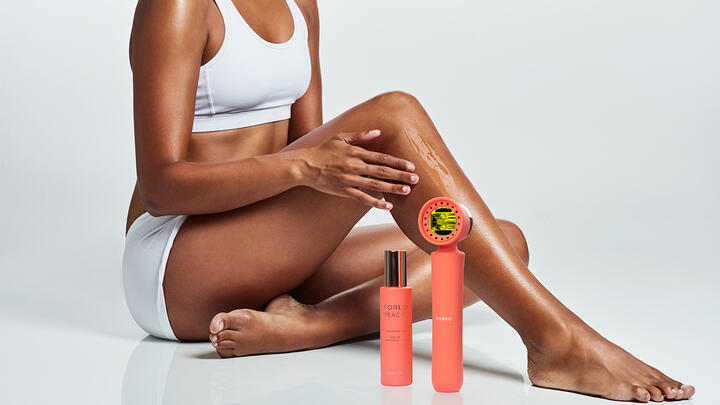6 min read
Everything You Wanted to Know About IPL Hair Removal Devices

Do you recall those situations when you're all set to slip into your favorite summer dress, only to realize that you haven't shaved your legs? So, you rush to the bathroom, prop one leg up on the bathtub's edge, and quickly get rid of those unwanted hairs. It's just a five-minute task, but did you know that, on average, women spend about 72 days (1,728 hours) of their lives solely shaving their legs?
So those "5 minutes" add up to a significant amount of time. In this scenario, IPL hair removal device comes to the rescue, and we're here to answer all your questions about it. From the difference between IPL and laser to whether you can use it on tattoos, we're bringing you a detailed guide on IPL hair removal.
What's the Difference Between IPL and Laser Hair Removal?
While both methods use a light source to target melanin in the hair follicles, IPL and laser are not the same. IPL stands for Intense Pulsed Light and works by emitting a broad spectrum of light that, below the surface of the skin, converts to heat energy, which interrupts the hair growth cycle.
Laser, on the other hand, uses a monochromatic coherent light source, which means only one color wavelength in one direction. This difference makes IPL suitable for almost all skin tones except darker skin tones, while laser treats all skin tones. Both devices are very effective at long-term hair removal. 
Which Skin Tones and Hair Colors Is IPL Suitable For?
Skin Tones
IPL device is made to work well on many different skin tones, ranging from light, medium to dark (pictured below). However, it is important to know that if your skin tone exceeds tone 5 shown on the chart below, you should not use the IPL device. The reason behind this is that since very dark skin absorbs more light energy, treating it may cause discomfort/pain and adverse effects such as burns, blisters, discoloration or scarring, risking injury to your skin. 
Hair Color
Regarding hair color, IPL devices work best on naturally black or brown hair. The treatment might be ineffective on light hair colors such as white, grey, blonde, or red. While it can still be used on these hair colors, the results might not be as effective as on darker hair shades.

Which Body Parts Can and Cannot Be Treated With IPL Therapy?
IPL devices are suitable for use on body hair and female facial hair below the cheeks. However, it is important to mention there are areas of the body on which you should NOT use an IPL device. These areas are directly on the nipples, genitals, or around the anus due to the reason that these areas may have a darker skin color and greater hair density. This means using the IPL device in these areas may cause discomfort, pain, or injuries such as burns, discolorations, or even scarring skin.
Can I Use an IPL Device if I Have Sensitive Skin or Certain Skin Concerns?
Additionally, in addition to the already mentioned parts on which IPL devices should not be used, you cannot use the device on blisters, scars, dark brown or black spots such as birthmarks, moles, or warts. The reasoning behind this is that the device may injure your skin or make existing conditions worse.
Skin conditions such as psoriasis, vitiligo, eczema, acne, herpes simplex, and active infections or wounds are also areas of the skin you should not treat with an IPL device.
Can I Use IPL if I Have Tattoos?
Avoid using IPL devices on tattoos! Instead, it's important to take extra care by covering these areas and proceeding to treat the skin around it.
This precaution ensures that the IPL treatment targets the intended areas effectively while safeguarding the tattooed skin. By carefully using the device you will at the same time receive the maximum benefits of the IPL device and minimize any potential risks of burns or discolorations for these skin areas.
Can Men Use IPL Devices?
Certainly! IPL devices are suitable for both men and women, although their effectiveness can differ based on various factors such as skin tone, hair color, and the thickness of the hair follicle. It's generally recommended for men to use IPL devices on areas below the shoulders, covering the chest, back, arms, stomach, and legs. It's advisable to avoid using IPL on the face, neck, or genital area.
Attempting IPL treatment on male beards or facial hair may result in uneven results.
How Often to Use IPL, and When Will I See the Results?
IPL devices are designed for long-term facial hair removal, typically requiring around a 12-week treatment plan with sessions scheduled once a week to achieve wanted results. However, you may begin to see initial results within the first two weeks of treatment.
How Long Should You Wait After the IPL Treatment to Go in the Sun Safely?
Do not expose treated areas to the sun. Wait at least 7 days after treatment before exposing treated skin to direct sunlight. Your skin may be extra sensitive following an IPL treatment and particularly susceptible to sunburn. Apply sunscreen (SPF 30 or greater) or cover the treated area with suitable clothing.
How to Take Care of Your Skin Before and After the IPL Treatment?
Before the treatment, cleanse your skin gently. LUNA™ 4 body, a massaging body brush, is clinically proven to remove 99% of dirt and oil from the skin with its soft silicone bristles. Equipped with T-Sonic™ pulsations, it cleanses, softens, and smooths the skin, leaving it fresh and revitalized after each use. The best part: aside from deep cleansing, it helps reduce breakouts on the body, improves the appearance of cellulite, and prevents strawberry skin and ingrown hair. After your skin is properly cleansed, shave the area you wish to treat.

After an IPL treatment, the skin can be sensitive, so it is important to take proper care. Firstly, as already mentioned, you should avoid exposing the treated areas to direct sunlight for at least 7 days. For the first 48 hours post-treatment, it is recommended to avoid hot showers, saunas, or steam rooms as these activities can irritate the skin.
Avoid harsh skincare products such as scrubs, exfoliants, perfumed lotions, and retinol. If you're using an IPL device on your face, don't apply makeup to treated skin for a few days. Gentle cleansing and moisturizing treated areas twice daily can help soothe and nourish the skin and promote healing.
We recommend PEACH™ Cooling Prep Gel, designed not only to calm and soothe skin during the treatment but also after the treatment. Nurturing and calming ingredients such as aloe vera and peppermint calm the skin, while 17 plant extracts intensely hydrate the skin, combating natural dryness and irritation. Lastly, if you notice any blisters forming under any circumstances, do not pick or scratch them because you will scar or infect the skin!

Which IPL Device Is the Fastest?
When it comes to choosing an IPL device, it's important to know how fast it works, how simple it is to use, and how effective it is.
PEACH™ 2 and its travel-size companion, PEACH™ 2 go, offer the perfect combination of speed, simplicity, and effectiveness for long-term hair removal. Both devices have more power and a 3x larger treatment window than other devices on the market, covering 3x the skin area at a time and allowing for full-body treatments in just 10 minutes. With a super fast flash, it's designed to deliver superior results.

Plus, we need to mention its built-in skin cooling system, which provides a comfortable hair removal experience. This 360° skin cooling system blows cool air onto the skin during treatment, making it the most comfortable IPL option available. Additionally, T-Sonic™ massage temporarily dilates pores, allowing the light pulses to reach the hair follicles more efficiently, further enhancing its effectiveness.
If the 10-minute full-body treatment still seems like more time than you're willing to invest in an IPL hair removal session, you can always opt for their faster and stronger younger sister, PEACH™ 2 Pro Max. This is a serious piece of machinery with an intense 120 J power and a professional-sized treatment window of 11.5 cm² to cover larger areas at once and allow you to do full-body treatment in a staggering 6 minutes. If you're unwilling to invest 6 minutes a week for long-term hair removal, maybe IPL is not right for you because PEACH™ 2 Pro Max IPL is as good as it gets.
So ditch the razor - because life's too short to spend 72 days of it on shaving.








Comments
6 comments
Leave a comment